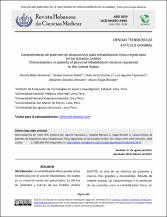| dc.contributor.author | Nieto-Gutierrez, Wendy | |
| dc.contributor.author | Tellez, Walter Andree | |
| dc.contributor.author | Pacheco, Niels Victor | |
| dc.contributor.author | Aguirre-Tipismana, Luis | |
| dc.contributor.author | Zevallos-Morales, Alejandro | |
| dc.contributor.author | Taype-Rondan, Alvaro | |
| dc.date.accessioned | 2020-07-20T19:25:42Z | |
| dc.date.available | 2020-07-20T19:25:42Z | |
| dc.date.issued | 2019 | |
| dc.identifier.citation | Nieto W., Tellez WA., Pacheco NV., Aguirre L., Zevallos A., Taype A. Características de patentes de dispositivos para rehabilitación física registradas en los Estados Unidos. Rev haban cienc méd. 2019; 18(2): 346-356. | es_PE |
| dc.identifier.uri | https://hdl.handle.net/20.500.12727/6374 | |
| dc.description | ABSTRACT
Introduction:
Physical rehabilitation can be benefitted from the use of devices, which are usually patented. The United States Patent and Trademark Office (USPTO) is one of the largest and most recognized patent and trademark offices. The characteristics and evolution of patents for physical rehabilitation is of great interest; however, there are few studies in this respect.
Objective:
To identify the characteristics of patents of physical rehabilitation devices for the physical rehabilitation of damaged limbs registered the United States Patent and Trademark Office.
Material and methods:
A cross-sectional descriptive study was conducted. A search was made at UPSTO using a list of keywords related to rehabilitation. Ten groups of patents related to rehabilitation were chosen. The variables studied were: patent number, publication date, country, holder, patent area, limbs for which the patent is useful, and portability. A descriptive analysis was performed by using STATA v.14.
Results:
A total of 1971 patents were analyzed, of which 16.2% were included in the rehabilitation groups and 83.8% in the physical exercise groups. The 36.6% of them were corporate-owned patents, 29.9% were portable, and 46.3% had usability which demonstrated to be useful for both extremities.
Conclusions:
Of the patents found, those focused on physical exercise were predominant. There is a greater number of useful patents for both extremities. In addition, there is an upward trend over time, the number of patents in the area of rehabilitation, and portable inventions. | es_PE |
| dc.description.abstract | Introducción:
La rehabilitación física puede verse beneficiada con el uso de dispositivos, los cuales en su mayoría suelen ser patentados. La oficina de patentes y marcas de los Estados Unidos (USPTO) es una de las oficinas de patentes y marcas más grandes y reconocidas. Resulta de interés evaluar las características y la evolución de las patentes para la rehabilitación física; sin embargo, existen pocos estudios al respecto.
Objetivo:
Identificar las características de las patentes de dispositivos de rehabilitación física de extremidades, registradas en la oficina de patentes y marcas de los Estados Unidos.
Material y métodos:
Estudio descriptivo transversal. Se realizó una búsqueda en UPSTO usando una lista de palabras clave relacionadas con la rehabilitación. Se eligieron 10 grupos de patentes relacionados con la rehabilitación. Las variables estudiadas fueron: número de la patente, fecha de publicación, país, titular, área de la patente, extremidades para las cuales es útil la patente y portabilidad. Se realizó un análisis descriptivo usando STATA v.14.
Resultados:
Se analizaron 1971 patentes, de las cuales 16,2% fueron incluidas en los grupos de rehabilitación y 83,8% en ejercicio físico. El 36,6% de todas las patentes fueron patentadas por un titular corporativo, el 29,9% fueron portables, y el 46,3% tenían utilidad para ambas extremidades.
Conclusiones:
De las patentes encontradas las enfocadas para ejercicio físico fueron las predominantes. Existe una mayor cantidad de patentes útiles para ambas extremidades. Además, existe una tendencia ascendente en el tiempo, en el número de patentes del área de rehabilitación y de las invenciones portables. | es_PE |
| dc.format.extent | pp. 346-356 | es_PE |
| dc.language.iso | spa | es_PE |
| dc.publisher | Universidad de Ciencias Médicas de la Habana | es_PE |
| dc.relation.ispartof | urn:issn:1578-2549 | |
| dc.relation.ispartofseries | Revista Habanera de Ciencias Médicas;vol. 18, no. 2 | |
| dc.relation.uri | http://scielo.sld.cu/scielo.php?script=sci_arttext&pid=S1729-519X2019000200346 | es_PE |
| dc.relation.uri | http://www.revhabanera.sld.cu/index.php/rhab/article/view/2416 | es_PE |
| dc.relation.uri | http://repositorio.usil.edu.pe/handle/USIL/9003 | es_PE |
| dc.relation.uri | http://repositorio.upch.edu.pe/handle/upch/7171 | es_PE |
| dc.rights | info:eu-repo/semantics/openAccess | es_PE |
| dc.rights.uri | https://creativecommons.org/licenses/by-nc/4.0/ | es_PE |
| dc.source | Repositorio Académico USMP | es_PE |
| dc.source | Universidad San Martín de Porres - USMP | es_PE |
| dc.subject | Patente | es_PE |
| dc.subject | Rehabilitación | es_PE |
| dc.subject | Medicina física y rehabilitación | es_PE |
| dc.subject | Ejercicio físico | es_PE |
| dc.subject | Terapia por ejercicio | es_PE |
| dc.subject | Investigación en rehabilitación | es_PE |
| dc.title | Características de patentes de dispositivos para rehabilitación física registradas en los Estados Unidos | |
| dc.title.alternative | Characteristics of patents of physical rehabilitation devices registered in the United States | es_PE |
| dc.type | info:eu-repo/semantics/article | es_PE |
| thesis.degree.name | Medicina Humana | es_PE |
| thesis.degree.grantor | Universidad de San Martín de Porres. Facultad de Medicina Humana | es_PE |
| thesis.degree.discipline | Medicina | es_PE |
| dc.publisher.country | CU | es_PE |
| dc.subject.ocde | https://purl.org/pe-repo/ocde/ford#3.02.00 | es_PE |








